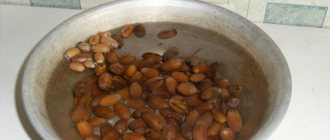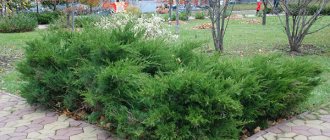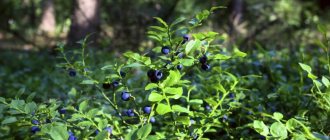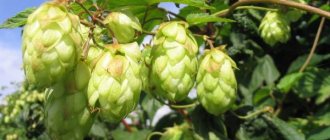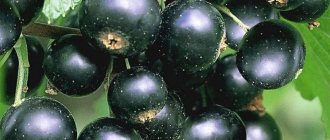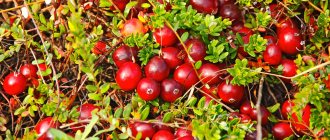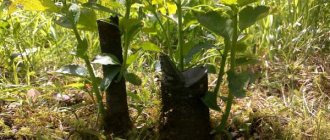Oak is a massive, strong tree; along with other wild trees, it is particularly majestic due to its spreading bushes.
The oak is considered the king of the forest; the tree grows for quite a long time; it will take more than 70 years to see a thick trunk. The peculiarity of such a tree is that for the first few decades it grows in length, after which it grows in thickness.
The roots of the tree grow deep into the ground, and young shoots always grow from the main trunk.
The oak loves sunlight; you can see how on the most illuminated edges of the pine forest an oak tree grows and stretches into the heights. Oak tolerates drought well, tolerates frosty winters, and also grows in any soil.
Acorns can be collected 14 years after planting the tree, but if the oak tree grows in an open, sunny place, the fruits ripen much earlier. To get a tree, you need to plant an acorn in the ground.
In Russia, certain varieties of oak trees are planted, namely pedunculate or summer oak. The wood of such a tree is considered strong and is suitable for building houses and furniture.
Oak panels are often used in the construction of ships and yachts, as they are resistant to pests. Bottle stoppers are made from oak bark; cork oak is specially grown for this purpose.
Oak bark is widely used in medicine to treat diseases of the oral cavity, throat, and is included in herbal collections that help with inflammation, some skin diseases, and burns.
Acorns are fed to pigs, and certain varieties are planted in parks as ornamental plants.
Chestnut-leaved oak has unusually beautifully shaped leaves; they are collected for the herbarium in September.
How to grow oak?
To plant an oak tree, the acorn must be fresh; from this harvest, dry fruits most likely will not sprout. Acorns are planted in the ground at the end of September before frost or in the spring after it.
It is recommended to add special fertilizers to the soil to prevent pests from appearing in the soil. When planted, oak fruits are often eaten by rodents underground, as a result of which the seed is lost.
To plant acorns in the ground in the spring, they must be stored properly throughout the winter. The temperature should be 0 degrees or slightly higher. The room should be humid, not stuffy. Most often, acorns are stored in the cellar.
In the fall, it is necessary to plant healthy fruits, which should be collected in dry weather and then dried in the window for five days. Before sowing, it is necessary to check the acorns for the presence of pests, worms or insects; it is enough to open several healthy fruits from the general collected heap.
The seeds suitable for planting have yellow seeds inside, the missing fruits inside are usually gray or brown.
You can check the suitability of the seeds for planting by soaking them in water; dead acorns will float to the top.
To plant an oak tree on your site, you need to mark the planting site before planting, namely, make long grooves 30 cm apart. The acorns are laid out in furrows at a distance of 10 cm from each other, after which they are covered with earth.
Birch - healing properties of sap and growing features + 121 photos
Apple tree: choosing a seedling, when to plant, care, harvesting, varieties and diseases of the apple tree. (120 photos of tree)
- Pine: a unique tree with a huge range of applications (77 photos)
The tree takes quite a long time to sprout; it will take time to see the first shoots, about two months. First, the root grows into the ground, strengthens, and then growth occurs on the stem itself.
It is recommended to plant the tree in the spring, since in the autumn the tree may sprout in unfavorable weather. Don’t be upset if after three weeks you don’t see shoots, give the seeds time; the rate of germination largely depends on the variety, the time of planting, and also on the soil.
You can dig up the ground a little, if the seeds sprout, then everything is in order.
Planting an oak tree, as you can see, is not a complicated process; the main rule for a good harvest is to find healthy, full-fledged fruits.
The oldest representatives of Russia and the world
Among the total number of oak trees existing today, there are those that can amaze with their longevity and interest in the legends written about them.
Mamvrian
In the Palestinian Authority, the Mamre Oak grew in Hebron. Scientists suggest that he managed to live more than 5 thousand years. According to biblical information, Abraham received God from this creation of nature. Around the middle of the 19th century. this tree was found by Archimandrite Antonin, a clergyman of the Russian Orthodox Church. He looked for those places that are described in the Bible. In 1868, the clergyman bought a plot of land with an oak tree.
Later, Russian pilgrims began to come here, and in the 20th century. The Holy Trinity Monastery was built on this site.
The Mamvrian creation of nature has always been looked after. People have formed a prophecy that with the death of the tree the end of the world will come. In 2021, the prediction was partially fulfilled: the dried-out trunk collapsed, but the apocalypse did not begin. In the area where the famous tree grew, young shoots remained. They will be the successors of the Mamre oak.
Stelmuzhsky
In Europe, one of the oldest trees is the Stelmuz oak. It is located in Lithuania. Today its height is 23 m, and its girth is 13.5 m. It is impossible to say exactly how many years the oak tree lives, because its core has rotted. Scientists put forward different versions. Some say that the oak tree grows for about 1 thousand years, while others believe that its duration of existence is more than 2 thousand years. According to the legend of the Stelmuzh Oak, several hundred years ago local residents created a pagan altar under the crown. In this place they made sacrifices to Perkunas, the thunder god and defender of justice.
Granitsky
In Bulgaria, in the village of Granit, the Granite oak has been growing for 17 centuries. During its existence, it reached 23.4 m in height. Local residents revere the tree because it bears witness to many historical events. People collect acorns to raise descendants of the Granite Oak.
The majestic tree of Bulgaria is gradually dying. It is supported by a special steel structure. According to experts, already 70% of the trunk is dead matter.
"Oak Chapel"
This oak has been living in France in the village of Allouville-Bellefosse for more than 1.2 thousand years. Its height is 18 m and its circumference is 16 m. About 40 thousand tourists come to this place every year. They are attracted by one feature: the chapels of the hermit and Our Lady of Peace were built in the hollow. They were created in the 17th century. The ascent to them is provided by a spiral staircase. Also, pilgrims gather annually at the chapel, created by nature and human hands, on the Catholic holiday of the Ascension of the Virgin Mary.
We recommend that you familiarize yourself with the Vitamin composition of tangerine
"The Hero of Taurida"
“Bogatyr of Taurida” grows in Simferopol in the Republic of Crimea and is a botanical natural monument. According to experts, life expectancy ranges from 500 to 700 years. This means that the tree has existed since the construction of the Kebir-Jami mosque in Simferopol.
There is one legend associated with the “Bogatyr of Taurida”. According to it, under the crown A.S. Pushkin wrote the poem “Ruslan and Lyudmila”, which contains lines about Lukomorye and green oak.
Pansky
In the Russian Federation, one of the oldest trees grows in the Belgorod region in the village of Yablochkovo. The oak is called Pansky. Its height is 35 m, and its girth is 5.5 m. It is over 550 years old. There are several legends about the Pan Oak. One of them says that in the 17th century. oak forests were cut down. Wood was required for the construction of fortified cities and the Belgorod abatis line. Only the Pansky Oak was not touched by anyone, because even at that time it amazed with its beauty and grandeur. Another legend says that Peter I rested under the shadow of the trunk and crown. This event occurred in 1709, when the tsar was returning from the Battle of Poltava.
Pests of oak trees
In the summer, powdery mildew often attacks the tree; the seedlings will not die from this, but will grow slowly. Fungal disease is treated with sulfur.
The tree can dry out due to insects that eat the bark from the inside, as well as the leaves. There are more than 180 species of oak pests, including caterpillars, butterflies, and mice.
Description and distribution of oak
This genus of plants, first identified in 1753 by Carl Linnaeus, has between 400 and 600 species. The distribution area includes most of the northern hemisphere, extending from temperate to tropical zones on different continents:
- America.
- Europe.
- North Africa and Asia.
North America has the largest number of species, with about 90 found in the United States and 160 in Mexico, of which 109 species are endemic. The second largest center of oak diversity is China, which is home to about 100 species.
In Europe, during the Ice Age, oak populations were limited to only three areas located in Spain, Italy and the Balkans. They later re-colonized the European continent. Today, oaks are keystone species in a wide range of Mediterranean semi-desert and subtropical forest habitats. They are also important components of deciduous forests.
In Russia, the most widespread species is the English oak (Quercus robur L). This species lives in northwestern Russia. In the east, the distribution area drops to the south, where the Ural Range is located, and then drops even further south. In western Russia and the Caucasus there is a species common in Europe called sessile oak. Both of these species are the main tree of the once vast Russian oak forests and groves, the area of which is becoming smaller every year.
How is oak useful?
Since ancient times, oak has been known for its medicinal properties. Bark, leaves, and fruits are used.
The bark has an astringent effect and is used to treat stomach ulcers, gastritis, and liver disease. Decoctions of oak bark are used in the treatment of gums, namely to reduce their bleeding. Oak is included in various useful ointments and dry preparations.
An infusion of oak acorns helps with skin diseases, burns, bleeding from the stomach, and food poisoning.
Cherry - description of the main varieties, rules of planting and care + 68 photos
Peach - cultivation, reproduction, diseases and varieties + 81 photos
- Cedar tree - description, cultivation, types of cedar and its beneficial properties + 77 photos
For diarrhea in children, a decoction of oak bark is used, and oak decoction is also used for tonsillitis, uterine tone, and pharyngitis.
If you have allergies, it is recommended to take baths with oak extract. For excessive sweating of the feet, foot baths are also performed.
A cooled decoction of oak bark helps to effectively eliminate burns, frostbite, and relieves pain locally.
How long do certain tree species live?
Let's first find out how long trees live under favorable conditions - if the tree grows in “its” climatic zone, without experiencing adverse effects.
Maple
The lifespan of a maple tree can reach 400-500 years. In Russia, such long-livers are rare. For example, the lifespan of the ash-leaf maple, imported from North America, does not exceed 100 years. Spreading tree with noticeable ornately shaped leaves.
Maple seeds can be carried very far - the two-winged fruits, falling, begin to rotate and, caught by the wind, fly away.
The height of maple plantations reaches 15-20 meters.
Beech
Beeches live 400-500 years. Widely distributed in European forests. Characteristic features:
- a smooth trunk that reaches a width of 2 m;
- maximum height – 30 m.
The tree grows slowly, but lives long. Beech has fruits that look like acorns. Moreover, they appear only in trees that have reached 40-50 years of age. Beech nuts have a unique ability to regulate metabolic processes.
Poplar
In nature, poplars grow for about 1000 years. This tree is actively planted in cities and along roads. If poplars have to grow in an unfavorable environment, they live less - 60-70 years.
Poplars can often be seen in industrial areas - they are planted here because of their ability to absorb radiation and harmful substances.
The height of poplars with columnar trunks reaches 35 meters. The leaves are round in shape. Poplar is a dioecious plant; there are female and male species. It is female trees that are the source of fluff, which causes allergies in many city residents.
Oak
Oak lives up to 1000 years. This is a well-known long-liver in our area. English oak (Quercusrobur) grows predominantly in Russia. There are approximately 600 species in the oak genus. Oak is easily recognized by its powerful trunk and spreading crown. Oak can also be unmistakably identified by the following characteristics:
- figured leaf of a uniquely beautiful shape;
- The original fruit is an acorn, which is adored by wild boars and pigs.
The tree is distributed throughout Europe. Oak wood is valued in furniture production.
Hornbeam
The hornbeam lives for about 300 years. It grows in Europe, less so in Transcaucasia and Asia Minor. It has a wide crown. Likes to grow in shaded deciduous forests. Growth is very slow. Belongs to the birch family. The leaves serve as excellent feed for livestock. Hornbeam fruits are used to obtain oil. Tree height – up to 30 m.
Linden
Linden lives on average 300-400 years, in some cases it can live 1000 years. There are many varieties of linden growing in Russia - Amur, Caucasian, large-leaved. The European linden can reach 40 meters in height. This beautiful tree is a source of linden blossom, which is actively used in cosmetology and medicine. Wood is easy to process - due to the softness of the fibers, it serves as an ideal raw material for carving.
Birch
The lifespan of birches is 100-150 years. If conditions are favorable, the tree can live 300 years. The distribution area of birch stretches from French lands to Altai. The most common species is the warty or weeping birch (Betula Verrucosa). Average indicators of birch:
- height – up to 45 m;
- trunk girth – up to 1.5 meters.
The tree has several dwarf subspecies.
A young tree has a completely smooth, light brown trunk. Birch acquires its famous trunk color – white with black stripes – only after reaching 8 years of age.
Birch leaves are small, in the form of rounded triangles, the edges are jagged.
Ash
The average lifespan of an ash tree is 500 years. Its fruits are in the form of lionfish, falling off in winter. It has sparse foliage that allows the sun's rays to pass through well. Peculiarities:
- tree height – up to 30 m;
- trunk width – up to 1 m;
Ash wood is particularly durable, which is why it is valued in construction. Ash bark, its fruits and wood sap are used in medicine.
Elm
On average, elms live up to 300 years. The tree can grow as a shrub. Young trees have smooth bark, which hardens with age. The leaves are elongated, the seeds are winged fruits. The height of the elm is up to 40 m.
It grows on plains and hills, in shady places and in open sunny heath.
Chestnut
Chestnuts live from 200 to 300 years. Differs in original flowers and leaves. The height of the chestnut is up to 35 m. The inflorescences are in the form of cones. In autumn the fruits ripen - they are in a spiky capsule. Painkillers are made from the fruit.
Aspen
Lives on average 80-90 years, rarely lives to be 150 years old. It has a columnar trunk. It reaches a height of 35 m. In diameter - up to 1 m. It burns poorly - it is not valued as fuel.
Alder
The lifespan of alder is about 100 years. This is a unique tree that can improve the soil - it is enriched with nitrogen fertilizers. Raspberries and other shrubs grow well near the alder. Height – up to 20 m.
Pine
The tree lives on average up to 600 years. This is one of the most common trees in the forests of Europe and Russia. Widespread varieties of pine:
- Siberian cedar - lives up to 500 years;
- European cedar - lives up to 1200 years.
Scots pine (Pinus sylvestris) covers over 20% of the territory of the former USSR. Its height is from 20 to 40 m.
Spruce
Lives from 600 to 1200 years - depending on the species. Grows all over the world. There are species that grow in a certain area. They reach a height of 50 m. It has a cone-shaped crown. Seeds appear in the 20th year of life - they are contained in cones.
Fir
On average, they live 300-400 years. Can live up to 700 years. Coniferous plant with vertically growing cones. The tree is evergreen. The needles do not fall off even after the branches dry out. The height of the fir depends on the species.
Yew
Lives from 1500 to 2000 years. Under favorable conditions it can live 3000-4000 years. Yew berry grows very slowly. Height – 10-20, sometimes up to 28 m.
Thuja
Thuja lives 150-200 years. It is classified as a coniferous plant, but it does not have needles. This evergreen tree is unpretentious to soil, so it is one of the most popular ornamental plants. It reaches a height of 2.5 m. Thuja folded or giant can grow up to 6 m in height, thuja occidentalis - up to 20 m.
Juniper
On average, junipers live 200-300 years. There are species of juniper that live 500 years or more. Height and lifespan depend on the species. Maximum height – 8-12 m.
Apple tree
Life expectancy is from 100 years, depending on the species. This tree happens:
- fruity;
- decorative;
- growing wild.
The maximum height is 15 m; there are also low-growing shrubs among the apple trees. Trees vary in frost resistance and moisture needs.
Pear
Lives on average 70 years. Some species can live up to 150 years. Fruiting continues up to 50 years. There are approximately 60 species. Height - up to 20 m. Does not like to grow in places with high groundwater levels. To make the tree live longer, it should be planted at higher elevations
Plum
The plum tree lives no more than 20 years. The tree bears fruit already in the third year of life. Prefers moist soils. Doesn't like drafts. Reaches 15 m in height.
Cherry
The lifespan of cherries is 25 years. Does not grow higher than 10 m. Compact and productive. One cherry bears up to 20 kg of fruit. In wild conditions it lives up to 5 years longer.
Cherries
This heat-loving tree lives 25-30 years. Much more whimsical than cherries. Gives tasty and juicy fruits. It reaches a height of 8-12 m.
Apricot
Lives up to 100 years. It reaches a height of 5-8 m. It is not able to regulate fruiting - because of this, there is an overabundance of fruits. Drought resistant.
Rowan
Lives 50-80 years. It happens that some individuals live up to 200 years. There are 190 species. It comes in the form of a tree and a bush. Height – 8-12 m.
Photo of oak
When does it bloom?
Oak blooms late in spring. Of all our trees, its leaves are the last to bloom. Although its natural slowness is a very useful thing, because in this way it completely protects its young shoots from possible cold and death. By the way, young trees are very sensitive to cold.
The leaves densely cover the oak crown. Interestingly, some species of this tree are evergreen: their leaves remain on the branches for several years. Other oak trees lose their leaves in the fall. On some trees, the leaves dry out directly on the branches and gradually collapse over the winter. The leaves on the evergreen species appear solid, whereas the leaves of the oak generally resemble blades. The leaves of this plant are dense.
The tree blooms when its leaves are small, so it looks very curly at this time. It blooms with earrings that look like hazel catkins. But only male flowers have this appearance; female flowers, which are very rare, bloom in small inflorescences resembling small grains. Acorns then emerge from them.
Oak is a very interesting tree, it is special, majestic and very beautiful. It is not without reason that all courageous heroes are compared with them in terms of fortitude and physical strength. Find out even more about it and how many years it lives, and what its density is from our video.
Varieties
The biological reference book lists several varieties of these giants of the plant world. Among them are common oak, pedunculate oak, and sessile oak. All representatives of the genus belong to the Beech family. Have you ever seen a deciduous tree that keeps its leaves all year round? So, among late oaks this is a common phenomenon. Early forms bloom in early April and shed their leaves for the winter. And the later ones wake up closer to May, so young trees can turn green all year round. In nature, individually growing trees are more common, and oak groves are less common.
